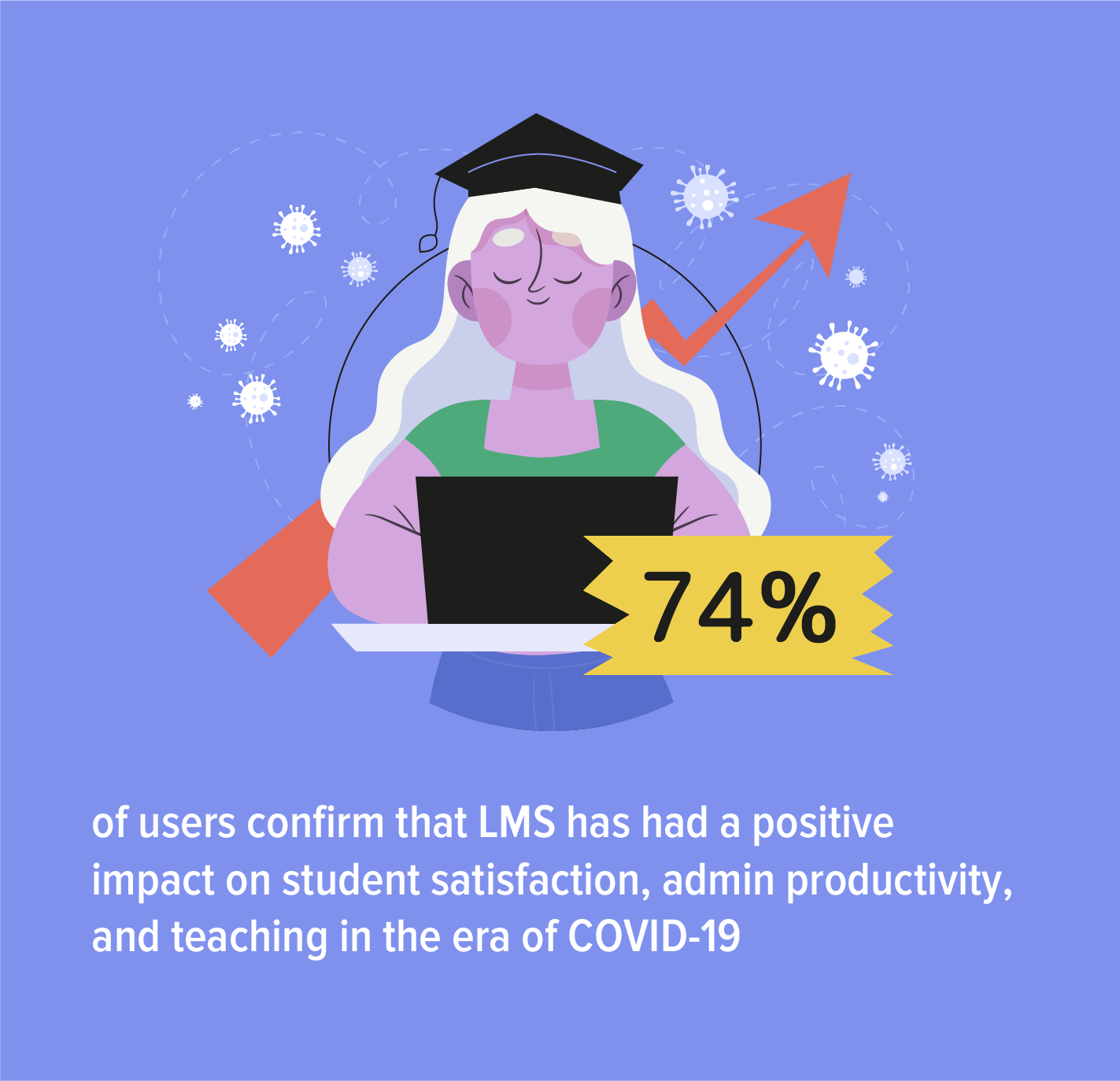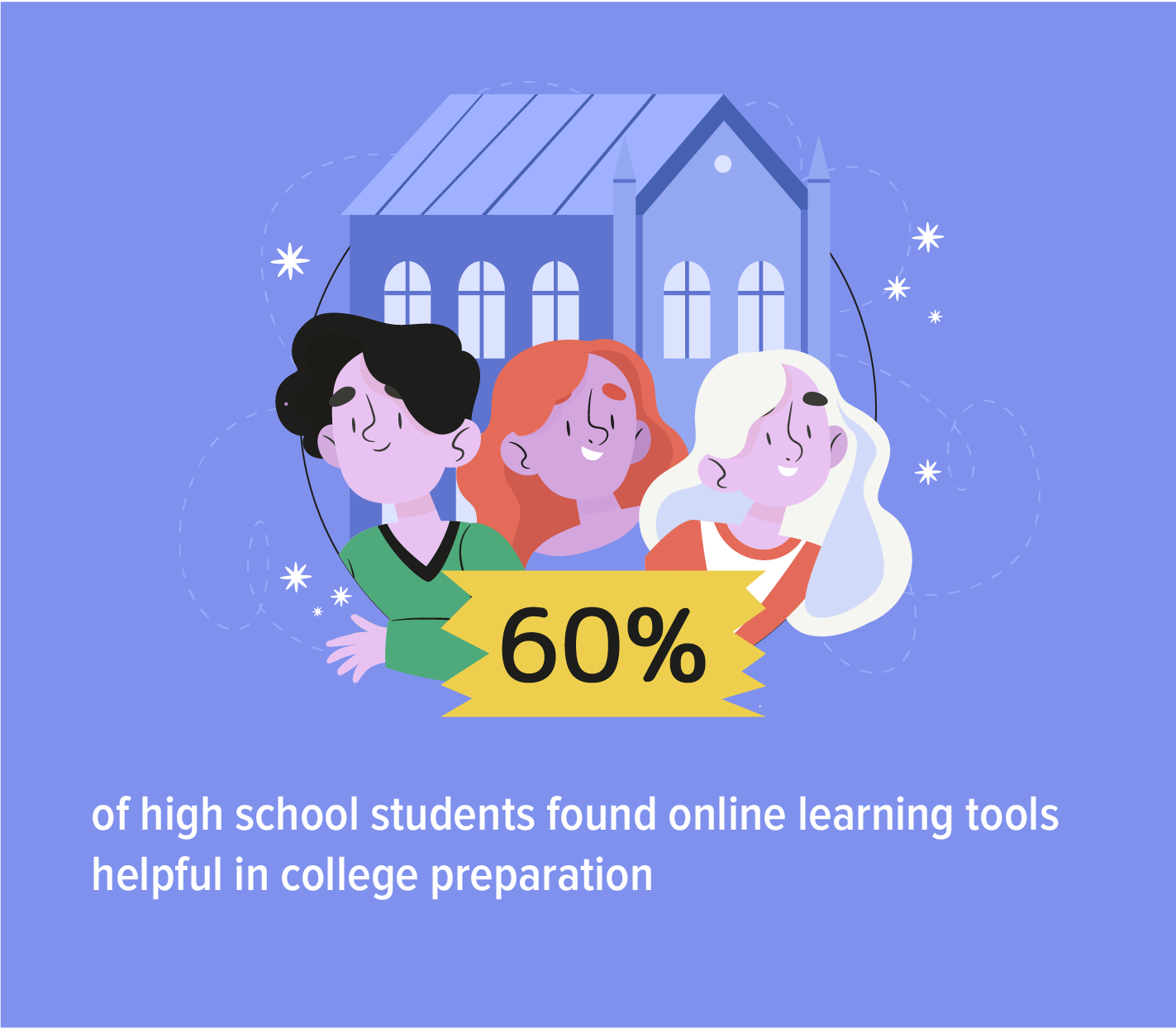LMS is one centralized cloud-based or server-based software program with various features that have the essential purpose of enabling learning and teaching. An LMS in education lets you take with ease administrating, documenting, delivering the content, and tracking students’ progress, particularly monitoring and assessing their performance.
What does an LMS mean in education?
Computer-based technologies have become part and parcel of today’s world, making people use them in many aspects of their lives. The number of middle schools using online learning as a part of a blended approach in education is immeasurably increasing nowadays.
According to statistics, the number of middle schools using LMSs is even twice as considerable as universities or colleges, which means that schools have become the leading users of LMSs in the education sector.
Moreover, their LMS experience is significantly positive, as 92% of surveyed LMS users noted that they were more than satisfied with their school’s current system.
How has COVID-19 affected an LMS in education?
You may wonder how COVID-19 has affected an LMS in education. COVID-19 demonstrates that LMSs can be an effective solution within education.
Key insights of using an LMS in education in 2021
-
In an environment of forced isolation, universities find that a robust learning platform is a guaranteed way to ensure stability and continuity for both staff and students.
-
The most successful online learning platforms should support departments that have already adopted blended or fully online learning and all the institution’s current educational and training activities.
-
A strategically expanded and supported learning platform is likely to be at the forefront of university initiatives and broader projects.
For many universities, this may be the first time educators have thought about online learning – and, as we have already observed, video conferencing has quickly supplanted day-to-day seminars and lectures. Interestingly, even for institutions with more experience with educational technology or those who already have a learning platform in use, COVID-19 has put this technology to the test in terms of mass adoption or going beyond the most straightforward use cases for repositories.
LMSs played a key role during the COVID-19 period. They also have strong potential in today’s classrooms. When they include tools that personalize learning, they become even more useful.
Currently, Open edX is among the best LMS software in the eLearning industry; hence, it is trusted by top organizations worldwide.
The role of an LMS in education
While LMSs have reached a high level of adoption in many countries, they are most prevalent in educational institutions. Research has shown how student-learning practices change due to the opportunities provided in an LMS. According to a 2019 survey, 71% of middle school students agreed that digital learning tools help them learn independently and make school more interesting, whereas 60% of high school students found online learning tools helpful in college preparation.
Granted that educational institutions can use an LMS to assess traditional skills in new ways, teachers can take on a more facilitative role in a modern, more prosperous learning environment.
Here are the key characteristics of using an LMS in education:
- LMS in education means the creation of an online course. To get a better idea of what LMS means in education, you should first investigate how to create an online course. Also, making a course involves understanding how to structure your online course.
- LMS in education means using a variety of LMS integrations. An LMS can handle all course messages and notifications to interested users. For example, an LMS can automatically send a report to all registered users when a teacher uploads a new assignment. The various LMS integrations are significant as they help LMS to perform some essential functions.
- LMS in education means distributing and checking homework assignments. An LMS gives educators a faster, more straightforward way to distribute, analyze, and grade students. An LMS contains special tools that help correct mistakes or provide feedback to evaluate the performed assignment. For example, the errors can be highlighted in red, notes with corrections can be done in the margins and a progress bar can be included. Educators can grade learners consistently and transparently and, on top of that, provide rich feedback in the customizable comment section.
- LMS in education means Report management. LMS can generate a wide variety of reports, including student performance, scores, student engagement, and more. This data can be used to provide valuable insights into the effectiveness of course content.
All these LMS characteristics prove to make the learning process more engaging and somewhat more interactive.
The top 6 benefits of using an LMS in education
Faced with an uncertain future and an emerging education technology market, many universities are looking for software to support and help deliver online learning solutions. It’s about time for the higher education sector to reconsider the benefits of introducing an LMS in their educational process.
1. LMS in education keeps students motivated and engaged.
By creating a familiar digital environment in education, teenagers will surely be more interested in the process of education. It won’t surprise that gamification is the most requested feature, and 26% of LMS for middle school users would prefer to have it integrated. A built-in reward system provides each student with badges for participation, projects completed, assessment grades, and other learning metrics. It dramatically boosts engagement and can even lead to teenagers giving up playing video games.
2. LMSs save a tremendous amount of time for teachers and administration
Once the educational program is created in a digital version, there’s no need to repeat the material for different students multiple times. LMS for middle school gives self-work space, involving the teacher’s help in crucial or difficult situations.
3. LMSs help students and teachers collaborate effectively.
Working on school projects offline is the traditional way. But using your LMS for middle school as a discussion board changes that. It helps students collaborate, manage projects together, and build stronger teamwork skills.
4. LMSs improve students’ self-discipline and flexibility.
Blended learning techniques require much more self-discipline from the learner than traditional learning methods. Calendar and deadlines in the LMS will come in handy. As teachers post the upcoming events, students take more responsibility for their results because they have more control over the learning process. Moreover, by using various content formats – webinars, podcasts, games, videos, presentations – students discover multiple ways to learn the material needed at a time.
5. LMSs in education provide deeper analytics of the learning process.
Learner analytics inside the middle school LMS system unlock deeper insights into much more data to make decisions. Any data you need to increase the learning process’s efficiency can be tracked, gathered, and analyzed.
The detailed analytics reports address the following key points:
-
Student’s interaction with the material
-
Time spent on assignments
-
Most or least rated courses, and so much more.
6. LMSs make the education process safe and friendly.
Antiviruses, antimalware, and IP blockers provide security and prevent information leaks, making LMS more secure than Zoom video calls and other apps. Simultaneously, the user interface of LMS for middle school is typically simple, and it doesn’t require any special prior training. A small demo session and prompts are usually enough for all users to handle the new learning environment.
LMS vendors often offer solutions to problems you might not even be aware of yet. These come through a wide range of features you can add to your system. Some were mentioned earlier, but exploring the full list is worth your time. It can enhance the blended classroom experience and make building your setup much easier.
Other features of LMSs in education
-
Instructor-Led Training Management: allows instructors to set a time and place for in-person training within an LMS session.
-
Virtual Classroom: a basis of the blended learning process;
-
Social Learning: mixes social networks with feeds and comment threads and encourages collaboration;
-
Learning Paths: customizing different parts of the course materials.
Alongside existing features, LMSs keep the education process evolving and somewhat engaging. Using LMS means adjusting to a changing reality every day and constantly developing education. Once you move from single courses to full programs, picking the best LMS for universities and colleges becomes a strategic decision, not just an IT task.
Educators, administrators, and institutions need to take new steps when implementing learning management platforms. It starts with clearly defining the institution’s goals. Those goals should then guide how the platform supports both teachers and students. Now more than ever, students are demanding reassurance that they can continue their studies without interruptions or academic problems. Likewise, educators need an adaptable and reliable infrastructure to support them during this period.
We are proud to be a reliable Open edX service provider for our clients. We have made and continue to invest in our technology platform, processes, and people to enable educational institutions to choose the best Open edX provider.
- What does an LMS mean in education?
- How has COVID-19 affected an LMS in education?
- The role of an LMS in education
-
The top 6 benefits of using an LMS in education
- 1. LMS in education keeps students motivated and engaged.
- 2. LMSs save a tremendous amount of time for teachers and administration
- 3. LMSs help students and teachers collaborate effectively.
- 4. LMSs improve students' self-discipline and flexibility.
- 5. LMSs in education provide deeper analytics of the learning process.
- 6. LMSs make the education process safe and friendly.
- Other features of LMSs in education







